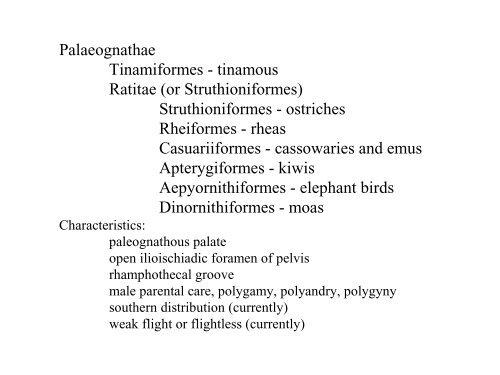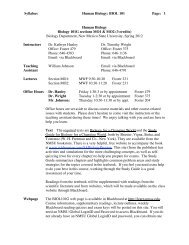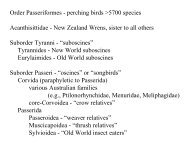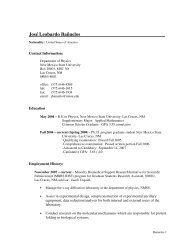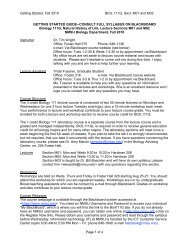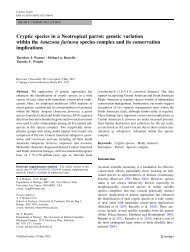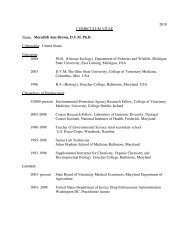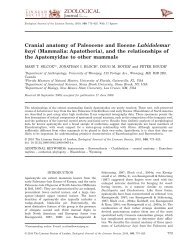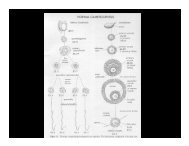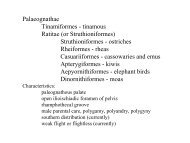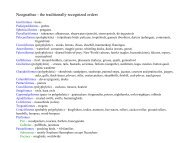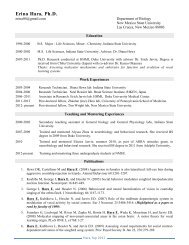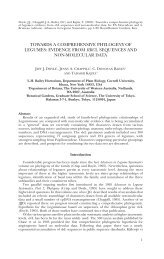Classification 1: Palaeognathae and Galloanserae.pdf
Classification 1: Palaeognathae and Galloanserae.pdf
Classification 1: Palaeognathae and Galloanserae.pdf
You also want an ePaper? Increase the reach of your titles
YUMPU automatically turns print PDFs into web optimized ePapers that Google loves.
<strong>Palaeognathae</strong><br />
Tinamiformes - tinamous<br />
Ratitae (or Struthioniformes)<br />
Struthioniformes - ostriches<br />
Rheiformes - rheas<br />
Casuariiformes - cassowaries <strong>and</strong> emus<br />
Apterygiformes - kiwis<br />
Aepyornithiformes - elephant birds<br />
Dinornithiformes - moas<br />
Characteristics:<br />
paleognathous palate<br />
open ilioischiadic foramen of pelvis<br />
rhamphothecal groove<br />
male parental care, polygamy, poly<strong>and</strong>ry, polygyny<br />
southern distribution (currently)<br />
weak flight or flightless (currently)
Paleognathous palate <strong>and</strong> rhamphothecal grooves
ilioischidic foramen<br />
open<br />
closed
Tinamiformes - tinamous<br />
~45 spp.<br />
Central <strong>and</strong> South America
Examples of tinamou eggs
Struthioniformes - ostrich 1 sp.<br />
Africa<br />
didactyl, sexually dimorphic
Rheiformes - rheas<br />
3 spp.<br />
South America<br />
tridactyl<br />
up to 60 eggs per clutch<br />
runs 60 kph
Casuariiformes Casuariidae<br />
cassowaries, 3 spp<br />
New Guinea <strong>and</strong><br />
Australia, tridactyl<br />
wattles, casque,<br />
spiked inner toe<br />
monomorphic<br />
forest dwellers
Casuariiformes - Dromaiidae<br />
Emus 1 sp. Australia<br />
tridactyl, slightly dimorphic<br />
gregarious, good tempered
Apterygiformes - kiwis, 3 spp. forests of New Zeal<strong>and</strong><br />
macrosmatic, poor eyesight, wisker-like oral rictae, nocturnal, hind toe
Monogamous<br />
Nests in burrows<br />
1, rarely 2, eggs per clutch
Distal rhynchokinesis<br />
Nostril located at tip of bill
Largest egg per body size of all birds
Aepyornithidae<br />
Elephantbirds<br />
Madagascar<br />
extinct
Dinornithiformes<br />
Moas<br />
New Zeal<strong>and</strong><br />
extinct
Neognathae<br />
<strong>Galloanserae</strong><br />
Galliformes - fowl<br />
Anseriformes - waterfowl<br />
Neoaves -all other birds
Cracidae - curassows ~38 spp. Central <strong>and</strong> South America, arboreal
Cracidae - also chachalacas <strong>and</strong> guans
Galliformes<br />
Megapodiidae - mound-builders<br />
11 spp, Australia, Malaysia<br />
monomorphic<br />
some with wattels <strong>and</strong> casques<br />
no incubation, no parental care
Numinidae - guinea fowl<br />
7 spp Africa, Madagascar<br />
monomorphic, casques, wattles<br />
gregarious, savannahs
Phasianidae<br />
~200 spp.<br />
cosmopolitan<br />
strongly sexually dimorphic
Phasianinae - pheasants
Phasianidae - also quail
Tetraoninae - grouse
Meleagrinae - turkeys
Anseriformes<br />
Anhimidae -screamers<br />
3 spp. South America, wetl<strong>and</strong>s<br />
fowl-like bill<br />
spurred wings, very lightweight
Anseriformes<br />
Anseranatidae - magpie goose, 1 spp, Australia, semipalmate
Anseriformes Dendrocygnidae - whistling ducks, 8 spp, pantropical
Anseriformes<br />
Anatidae - ducks, geese, swans<br />
Tachyeres -steamer ducks<br />
Cairininae - perching ducks<br />
Oxyurinae - Stifftail ducks
Aythyinae -pochards<br />
Tadorninae - shelldrakes<br />
Merginae - mergansers<br />
<strong>and</strong> sea ducks
Anserinae - geese<br />
Merganetinae - torrent ducks<br />
Anatinae - dabbling ducks<br />
Cygninae - swans


